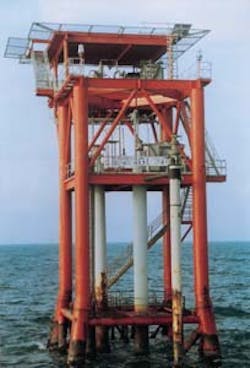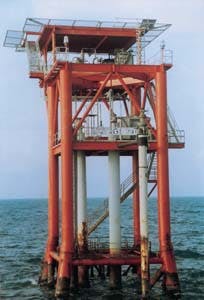PLATFORM/PIPELINE CONSTRUCTION Containing field abandonment costs in the Gulf Of Mexico
L. Randy Chapman
Chapman ConsultingAlan Coats
Craig Lajaunie
Preeminent Energy Services
To the oil and gas operator, plugging and abandoning an existing well or field means significant expenditures in both engineering man-hours and allocated funds. This cost liability of expending funds without the opportunity of any return on those funds emphasizes the need to efficiently plan and execute these operations in the most cost effective manner.
Field abandonment is a complex task involving the successful coordination of many different groups performing a multitude of activities. Piping crews, lifting crews, diving personnel, boat personnel, well service personnel, explosives experts, and regulatory observers may be present on site during abandonment operations. The successful interaction between these groups is critical in performing an efficient abandonment.
Project management
Thorough project planning and scheduling is essential to obtaining a properly executed and cost effective field abandonment. Preparation of a detailed written project schedule is essential for abandonment work. This comprehensive schedule serves as a detailed checklist for each operation and ensures that the multitude of functions and activities involved are considered and performed in the optimum sequence. The schedule also serves as a communication tool which clarifies and defines the responsibilities and relationships between the various operators, contractors, and subcontractors on location.
Project management work should begin early so as to allow scheduling the work to take best advantage of optimum weather seasons and to avoid peak premium-priced work periods. It is our experience that the optimum time for performing the actual field operations for abandonment in the Gulf of Mexico is June and July.
This period is just after the spring windy season and prior to intense tropical weather activity. This timing historically avoids the peak work periods of late summer and early fall when most of the construction work occurs in the Gulf of Mexico. Planning a heavy lift and other expensive offshore construction equipment operations for the best weather/minimum cost work periods helps avoid unnecessary expenses for the project. Early planning can also avoid having to work under the constraint of a regulatory deadline that can dominate your scheduling and drastically increase your abandonment cost.
Field abandonment generally consists of plug and abandonment of the wellbores, pipeline decommissioning and abandonment, facilities decommissioning, structure removal, site clearance, and site clearance verification.
With environmental and safety requirements, holding down costs of removing the simplest offshore structure requires coordination of many activities.
Plug and abandonment
Plug and abandonment of the wellbore begins with a site survey and the preliminary injectivity pumping and wireline well work. Producing zones are then isolated with cement squeezes, balanced plugs, and/or bridge plugs. Cement squeezes can be circulated or bullheaded to depth or can be placed via coiled tubing. Balanced cement plugs are set across casing shoes to ensure against leaking pressure. Any outside casings that do not have pressure integrity are squeezed with cement slurries.
A predetermined amount of tubing and casing is removed along with the wellhead, and a surface cement plug is set. Casings and tubing can be severed by utilizing either slickline or electric wireline services. Requirements for abandonment of the wellbore are set forth in the Code of Federal Regulations (CFR) 250.110, 250.111, and 250.112. Upon completion of this phase of the project a final report is prepared to verify the procedures and document any deviation from the procedure.
Decommissioning
- Pipelines: Pipeline decommissioning and abandonment in OCS waters generally consists of thoroughly cleaning the interior of the pipeline and abandoning the line in place. After cleaning, the ends of the pipeline are generally plugged and then buried, if burial was originally required for the line. This operation also involves removing a small section of the line near the platform in order to ensure that the abandoned pipeline is not disturbed by the platform removal operation. Other actions may be required for line crossings, side tap connections or other special pipeline characteristics.
- Facilities: Facilities decommissioning consists of cleaning, disconnection, isolation and preparation for removal of the facilities equipment. Cleaning involves removing all liquid from the equipment, including lube oil from rotating equipment and electrical transformers, then flushing process equipment with water until clean.
The extent to which the facilities equipment is disconnected and isolated depends largely upon whether the equipment will be lifted with the structure's deck sections or lifted separately. It is sometimes required to remove the equipment, or selected items of equipment, on a piece by piece basis if the decks or deck padeyes cannot safely support the combined weight of deck and facilities, or if the lifting equipment is limited in its lift capacity.
- Lifting preparation: In this case, many piping and structural disconnections must be made in preparation for lifting. The primary philosophy in disconnection is to treat all systems as potentially explosive even though they have been flushed and cleaned. Open-ended piping and equipment connections should be isolated or closed by reliable methods as soon as practicable so as to minimize the potential of fire and pollution.
In regard to lifting of equipment, all padeyes or other lifting points should be design verified to ensure that they are adequate for the intended lift weights.
Structure removal
Structure removal is the most costly operation in the field abandonment process, primarily due to the large and expensive equipment that is required for the lifting operations. Some of the major considerations of removal are the heavy lifting method, the method of cutting the piling, piling access for the cutting operation, diving requirements, water depth, size, weight, tie-down and transportation considerations of each removed component, and the planned disposition of the salvaged equipment and structure.
The heavy lifting equipment is usually a derrick barge. There are also jackup drilling rig structures and ships fitted with high-capacity cranes available for heavy lifting. Large lift boats (jackup boats) with cranes typically of 30-70 tons capacity can sometimes be used to remove single well free-standing caissons and to assist in removal operations in water depths typically less than 100 ft.
In some cases, it may be cost effective to employ the use of temporary platform mounted modular cranes or lift boats to remove casing, drive pipe, facility skids and to assist in the preparation for derrick barge lifting. Since the derrick barge is usually the highest cost item on location, the use of other less expensive support equipment to minimize the heavy lifting equipment time is often justifiable. In fact, minimizing the derrick barge time is one of the primary considerations in the abandonment scheduling process.
Heavy lifting equipment must be evaluated for its lifting capacity at the required working radius and also for its height capability. Friction and suction loads must be considered in determining lift capacity requirements. Piling cut explosively will have flared and jagged ends which significantly increase the friction forces during removal.
Due to the batter (slope) of the jacket legs, the 15 ft of piling below mudline must pass through the soil in a sideways manner if the piling is removed with the jacket. The batter of the piling also complicates removal of the piling from the jacket in that it increases the frictional pull considerably.
Pile cutting
The method of cutting the piling affects the scheduling of events for the cutting operation. Examples of this are as follows:
- Explosive cutting: This method can be completed quickly, but is subject to extensive delays due to required procedures for preventing harm to marine mammals and turtles. In OCS waters, National Marine Fisheries Service ( NMFS) observers are required to be present to monitor for the presence of marine mammals and turtles. Their observation is done via the operator's helicopter and boat for prescribed times prior to, during, and after detonation.
For most species, the NMFS does allow a certain mortality rate, but the sighting or presence of any of the listed species will drastically delay the detonation. Furthermore, explosions are limited to daylight hours only. This fact, coupled with the time requirements for the observation and detonation procedures, seriously limits the time window for shooting the charges.
The chances of having 12 hours or more of standby time waiting on the next time window are significant. This is particularly true if some piles are not completely cut and second shots are needed to complete the severance. In this case, the entire NMFS observation procedure must be repeated prior to the next detonation.
Typically, once pile access is obtained, charges can be set in a four pile and ready to fire in less than 4 hours. The severance is completed in a few seconds after detonation. However, due to the observation procedures described above, the entire set-observe-shoot-observe cycle takes at least 5 to 6 hours, which makes it very difficult to shoot more than one sequence per day should it be required.
- Sand cutting: This method takes much longer than explosive cutting, typically 8-16 hours per 48-in. cut, but it has many advantages over explosive techniques. It does not require the NMFS observers, dedicated helicopter or boat, which are required for explosives. Most of the sand cutting can be done at a relatively low spread cost (prior to derrick barge arrival), so that the overall cost of sand cutting can be competitive with explosive methods. The permitting process which is required for explosives is not required for sand cutting.
It is generally not practicable to prove that piling is completely severed by either method prior to the arrival of the derrick barge. Whereas, it is accepted procedure to prove severance by partially jacking-out drive pipe and casing strings, most piling can not be accessed for this purpose. This fact is occasionally a source of significant additional cost when additional barge time is incurred due to an incompletely cut piling.
Pile access
Pile access for the cutting operation is usually achieved by removal of the deck structure for piling installed inside the jacket legs. However, it is often advantageous to access the piling through large slots or windows cut into the legs of the deck structure.
Skirt piles, which extended only 20-30 ft above the mudline are accessible at any time, but require significant diving or other special methods to stab into these piles since they are located completely under water.
It must be assumed that all piles require cleaning out to somewhat deeper than the planned severance depth, usually at least 19 ft for a planned cut at the 16-ft level, which is typical for most areas where OCS regulations require structure removal down to 15 ft below the natural bottom.
Additional distance below cutting depth should be allowed due to fill from soil which later falls from the inside of the piling, and settling of solids from the pile washing or cleanout operation. It also acts as a rat hole in providing additional assurance that either the explosive charges can be set or that the sand cutting tools will have good access. Additional depth is also important in that it allows room for a recut in undisturbed pipe if the first cutting attempt encounters difficulties.
Occasionally, pile access from the inside is prevented by certain types of stabbing guide assemblies, diaphragm plates, or other obstructions. If the obstruction cannot be removed expediently, it may be necessary to cut the pile from the outside manually using divers. In this case, the pile must be excavated down to past the specified cut depth.
This process can be expedited considerably by the use of a sectionalized cofferdam structure that can be installed around the pile. The dam is such that the annulus between the dam and the pile is large enough for a diver to operate airlift and cutting equipment and holds back the loose soil and prevents the excavated hole from filling in This method can considerably reduce the quantity of soil that must be removed and dramatically speeds the excavation process
Diving
Diving is an essential part of any marine field abandonment. Air diving is the obvious choice down to 130-160 ft for operations requiring detailed diving activities. Mixed gas is usually used from 150-230 ft for similar operations. Mixed gas is usually used for depths from 200-800 ft. Proprietary atmospheric pressure dive suits are available for deeper depths and may also be useful in moderate depths. Remotely operated vehicles (ROV) have reduced the need for manned diving in some limited applications and is a valuable tool in supplementing manned diving operations.
Another extremely valuable system that can supplement diving operations, and which makes certain operations much more productive, is the portable stationary sonar system. It is particularly useful in site clearance operations. It can identify which areas justify a dive and can be used to effectively guide a diver to an exact location to verify a suspected debris item. It can be used in locating most underwater objects that project above the mudline.
Size, weight, lifting and tie-down considerations of each removed component must be carefully considered. The transportation requirement of each removed component must be evaluated since bridge and powerline height clearances and canal widths and depths must be adequate for any transportation route inland. This consideration can often limit the disposition options available for many structures.
AUTHORS
L. Randy Chapman(P.E.) is the president of Chapman Consulting (Mandeville, Louisiana, US). He has 21 years experience in facilities, pipeline, and structural engineering with Exxon, Freeport McMoRan and Chapman Consulting. He holds BS and MS degrees in mechanical engineering.
Alan Coats is vice president of business development for Preeminent Energy Services (New Orleans, Louisiana). He has held management and technical positions for Otis Engineering and Halliburton. He holds BS, MA, and post graduate degrees in management.
Craig Lajuanie is the operations manager for the well abandonment division of Preeminent Energy Services (Lafayette, Louisiana). He has 21 years of experience in sales, service, and management of wireline completions, explosives handling, and well abandonment, and served on the API committee on explosives safety.
Copyright 1995 Offshore. All Rights Reserved.




